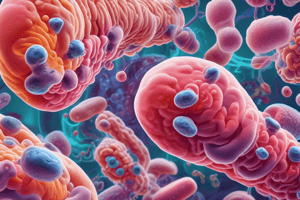Podcast
Questions and Answers
What term is used to describe microbes that colonize the human body but do not typically cause disease?
What term is used to describe microbes that colonize the human body but do not typically cause disease?
Which of the following factors does NOT affect the makeup of the human microbiota?
Which of the following factors does NOT affect the makeup of the human microbiota?
What effect do normal microbiota have on harmful microbes?
What effect do normal microbiota have on harmful microbes?
What is true about opportunistic pathogens?
What is true about opportunistic pathogens?
Signup and view all the answers
What happens to Clostridium difficile when antibiotics eliminate normal microbiota?
What happens to Clostridium difficile when antibiotics eliminate normal microbiota?
Signup and view all the answers
What is the term used to describe the interval between infection and the first appearance of symptoms?
What is the term used to describe the interval between infection and the first appearance of symptoms?
Signup and view all the answers
During which period do overt signs and symptoms such as fever and chills occur?
During which period do overt signs and symptoms such as fever and chills occur?
Signup and view all the answers
What describes the period when the body's defense mechanisms are weakened, making a patient vulnerable to secondary infections?
What describes the period when the body's defense mechanisms are weakened, making a patient vulnerable to secondary infections?
Signup and view all the answers
Which of the following is NOT a human reservoir for disease?
Which of the following is NOT a human reservoir for disease?
Signup and view all the answers
What is the role of carriers in disease transmission?
What is the role of carriers in disease transmission?
Signup and view all the answers
Which of the following is considered a nonliving reservoir of infection?
Which of the following is considered a nonliving reservoir of infection?
Signup and view all the answers
What term describes diseases that primarily occur in animals but can be transmitted to humans?
What term describes diseases that primarily occur in animals but can be transmitted to humans?
Signup and view all the answers
What is the primary period of recovery when the body returns to its pre-diseased state called?
What is the primary period of recovery when the body returns to its pre-diseased state called?
Signup and view all the answers
What type of transmission occurs when a susceptible host comes into direct physical contact with an infected person?
What type of transmission occurs when a susceptible host comes into direct physical contact with an infected person?
Signup and view all the answers
Which of the following is a common fomite that can transmit diseases?
Which of the following is a common fomite that can transmit diseases?
Signup and view all the answers
What is the primary purpose of using personal protective equipment (PPE) in healthcare settings?
What is the primary purpose of using personal protective equipment (PPE) in healthcare settings?
Signup and view all the answers
Which of the following diseases is transmitted via indirect contact transmission through contaminated surfaces?
Which of the following diseases is transmitted via indirect contact transmission through contaminated surfaces?
Signup and view all the answers
Which of the following routes is NOT a principal route for the transmission of disease?
Which of the following routes is NOT a principal route for the transmission of disease?
Signup and view all the answers
Which of the following examples represents droplet transmission?
Which of the following examples represents droplet transmission?
Signup and view all the answers
Which condition can be contracted from improperly prepared or stored foods?
Which condition can be contracted from improperly prepared or stored foods?
Signup and view all the answers
Which of the following is an example of direct contact transmission?
Which of the following is an example of direct contact transmission?
Signup and view all the answers
Which characteristic of viruses allows them to effectively evade host defenses?
Which characteristic of viruses allows them to effectively evade host defenses?
Signup and view all the answers
What is one of the cytopathic effects that viruses can induce in a host cell?
What is one of the cytopathic effects that viruses can induce in a host cell?
Signup and view all the answers
Which phenomenon is characterized by the formation of giant cells due to the fusion of adjacent cells infected by viruses?
Which phenomenon is characterized by the formation of giant cells due to the fusion of adjacent cells infected by viruses?
Signup and view all the answers
Which of the following is NOT a cytopathic effect caused by virus infections?
Which of the following is NOT a cytopathic effect caused by virus infections?
Signup and view all the answers
What effect does a virus have on the mitotic activity of host cells?
What effect does a virus have on the mitotic activity of host cells?
Signup and view all the answers
Which transmission method involves droplet nuclei resulting from sneezing or coughing?
Which transmission method involves droplet nuclei resulting from sneezing or coughing?
Signup and view all the answers
What is the primary means by which pathogens enter through the respiratory tract?
What is the primary means by which pathogens enter through the respiratory tract?
Signup and view all the answers
Which of the following pathogens is primarily transmitted through the gastrointestinal tract?
Which of the following pathogens is primarily transmitted through the gastrointestinal tract?
Signup and view all the answers
What term describes the ability of pathogens to cause disease by overcoming host defenses?
What term describes the ability of pathogens to cause disease by overcoming host defenses?
Signup and view all the answers
What is a common vector that can aid in the biological transmission of pathogens?
What is a common vector that can aid in the biological transmission of pathogens?
Signup and view all the answers
Which portal of entry is most commonly associated with sexually transmitted infections?
Which portal of entry is most commonly associated with sexually transmitted infections?
Signup and view all the answers
How can pathogens enter through the parenteral route?
How can pathogens enter through the parenteral route?
Signup and view all the answers
Which of the following best describes the ID50 measure?
Which of the following best describes the ID50 measure?
Signup and view all the answers
What is a common characteristic of pathogens that enter the body through broken skin?
What is a common characteristic of pathogens that enter the body through broken skin?
Signup and view all the answers
Which statement about preferred portals of entry is true?
Which statement about preferred portals of entry is true?
Signup and view all the answers
What type of toxin is produced inside bacteria and involves the release of lethal substances upon cell lysis?
What type of toxin is produced inside bacteria and involves the release of lethal substances upon cell lysis?
Signup and view all the answers
Which type of toxin is primarily associated with the stimulation of an immune response and the production of cytokines?
Which type of toxin is primarily associated with the stimulation of an immune response and the production of cytokines?
Signup and view all the answers
Which syndrome can be caused by endotoxins from gram-negative bacteria leading to dangerously low blood pressure?
Which syndrome can be caused by endotoxins from gram-negative bacteria leading to dangerously low blood pressure?
Signup and view all the answers
What is a key difference between exotoxins and endotoxins in terms of their composition?
What is a key difference between exotoxins and endotoxins in terms of their composition?
Signup and view all the answers
What can the presence of endotoxins in the body lead to in terms of blood circulation?
What can the presence of endotoxins in the body lead to in terms of blood circulation?
Signup and view all the answers
Which of the following bacteria is known to produce endotoxins and is associated with typhoid fever?
Which of the following bacteria is known to produce endotoxins and is associated with typhoid fever?
Signup and view all the answers
What type of toxin is specifically characterized by being released only upon the lysis of the bacterial cell?
What type of toxin is specifically characterized by being released only upon the lysis of the bacterial cell?
Signup and view all the answers
Which of the following symptoms can result from the immune response to endotoxins?
Which of the following symptoms can result from the immune response to endotoxins?
Signup and view all the answers
Study Notes
Exam 4 - Study Guide
- Question 1: Septic shock is a serious condition where a body-wide infection causes dangerously low blood pressure.
Chapter 14
- Terminology: Defines terms like pathogen, pathology, disease, infection, signs, symptoms, communicable and contagious diseases.
- Classification of Diseases: Covers disease occurrence (sporadic, endemic, epidemic), duration (acute, chronic, latent), and extent of host involvement (local, systemic, focal).
- Transmission of Pathogens: How disease-causing microorganisms travel from a reservoir of infection to a susceptible host.
Chapter 15
- Stages of Disease Development: Five-step sequence describing the stages of disease.
- Routes of Infection: Describes various entry routes and preferred portals for pathogens.
- Pathogenic Properties: Lists and describes characteristics of bacteria that allow them to access and penetrate the host defense system.
- Cytopathic Effects: Lists and describes cytopathic effects caused by viruses.
- Exotoxins and Endotoxins: Differentiation between exotoxins and endotoxins, and their roles in disease.
Chapter 21
- Skin Structure: Brief review of skin structure.
- Bacterial Skin Infections: Covers impetigo, scalded skin syndrome, toxic shock syndrome, and necrotizing fasciitis, and describes bacterial characteristics relating to each disease.
- Pseudomonas Skin Infections: Includes Pseudomonas aeruginosa, its characteristics, types of infections, and treatment options.
- Acne: Describes three types of acne (comedonal, inflammatory, nodular cystic) and relevant treatments.
Studying That Suits You
Use AI to generate personalized quizzes and flashcards to suit your learning preferences.
Related Documents
Description
Prepare for your exam with this comprehensive study guide covering key concepts from Medical Microbiology Chapters 14 and 15. Topics include the terminology of diseases, classification, pathogen transmission, and stages of disease development. Understand crucial details about infection routes and bacterial properties to excel in your understanding of microbiology.





